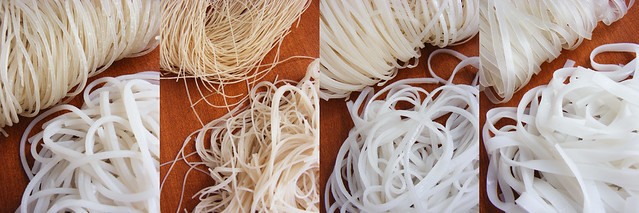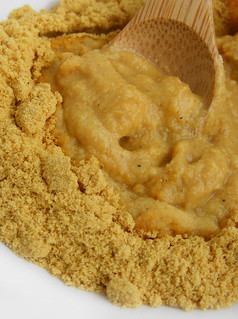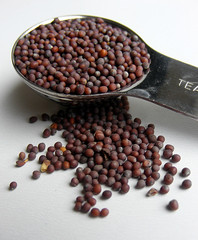
What’s it called?
Rice noodles, rice noodles, sen gwi dtiaw (Thailand)
Broad ones: banh pho (Vietnam), sen yai (2cm) / sen lek (1⁄2 cm) (Thailand), hé fěn / 河粉 (China)
Thin ones: rice vermicelli / mihoen / mihun / bihoen / bihun, mí fěn / 米粉 (China), banh hoi (Vietnam), sen mii (Thailand), laksa (Maleisia).
What is it?
To make (broad) rice noodles, rice flour (which is simply ground rice) is mixed with water into a slurry. This slurry, spread out in a thin layer is being steamed before it’s cut into different size. (see clip). Fresh rice noodles are soft and slippery, but in the West we mainly know them dried, which makes them a bit firmer. To improve texture or colour producers often add a little bit of corn flour or tapioca flour to the slurry. The (thin) rice vermicelli is often made a little bit different, a slightly thicker dough is being extracted into this strings and those strings are getting steamed or boiled. (see clip).
How to use it?
Rice noodles are already prepared/cooked when produced, that way you don’t need to cook them at home. Normally it’s enough to re-hydrate them in hot or warm water. It depends on the thickness how long you need to soak them, usually you can find a good indication on the package. They just need to soften up. You can shorten the soaking time when you are going to further use them in soup or stir-fries. For soups you could even decide to rehydrate them in the soup. Soak to perfection if used for Thai salads, just rinse in cold water to stop the process, then add a litte (sesame) oil to prevent them from sticking together. When you deepfruy (175°C) rice vermicelli (unsoaked) it will swell up into crunchy strings.
Tips, Tricks & recipes
- Sometimes you can find fresh rice sticks/sheets in the fresh department. They’re much softer and more slippery than dried noodles.
- Don’t confuse rice vermicelli with: glass noodles. Glass noodles will keep their texture where rice vermicelli will clog together when cooked/heated too long
- Most famous rice noodle dish from Thailand: Pad Thai
Most famous rice noodle dish from Vietnam: Pho
A famous rice noodle dish from China: Cinnamon Beef Noodles



